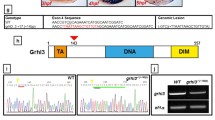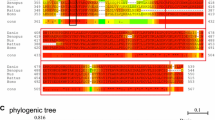Abstract
FGFR1 is an important signalling molecule during embryogenesis and in adulthood. FGFR1 mutations in human may lead to developmental defects and pathological conditions, including cancer and Alzheimer’s disease. Here, we describe cloning and expression analysis of the zebrafish fibroblast growth factor receptor 1 (fgfr1). Initially, fgfr1 is expressed in the adaxial mesoderm with transcripts distinctly localised to the anterior portion of each half-somite. Hereupon, fgfr1 is also strongly expressed in the otic vesicles, branchial arches and the brain, especially at the midbrain-hindbrain boundary (MHB). The expression patterns of fgfr1 and fgf8 are strikingly similar and knock-down of fgfr1 phenocopies many aspects observed in the fgf8 mutant acerebellar, suggesting that Fgf8 exerts its function mainly by binding to FgfR1.





Similar content being viewed by others
References
Amaya E, Stein PA, Musci TJ, Kirschner MW (1993) FGF signalling in the early specification of mesoderm in Xenopus. Development 118:477–487
Brand M, Heisenberg CP, Jiang YJ, Beuchle D, Lun K, Furutani-Seiki M, Granato M, Haffter P, Hammerschmidt M, Kane DA, Kelsh RN, Mullins MC, Odenthal J, van Eeden FJ, Nusslein-Volhard C (1996) Mutations in zebrafish genes affecting the formation of the boundary between midbrain and hindbrain. Development 123:179–190
Burgar HR, Burns HD, Elsden JL, Lalioti MD, Heath JK (2002) Association of the signalling adaptor FRS2 with fibroblast growth factor receptor 1 (Fgfr1) is mediated by alternative splicing of the juxtamembrane domain. J Biol Chem 277:4018–4023
Chi CL, Martinez S, Wurst W, Martin GR (2003) The isthmic organizer signal FGF8 is required for cell survival in the prospective midbrain and cerebellum. Development 130:2633–2644
Ciruna B, Rossant J (2001) FGF signaling regulates mesoderm cell fate specification and morphogenetic movements at the primitive streak. Dev Cell 1(1):37–49
Cote GJ, Huang ESC, Jin W, Morrison RS (1997) Sequence requirements for regulated RNA splicing of the human fibroblast growth factor receptor-1 a exon. J Biol Chem 272:1054–1060
Deng CX, Wynshaw-Boris A, Shen MM, Daugherty C, Ornitz DM, Leder P (1994) Murine FGFR-1 is required for early postimplantation growth and axial organization. Genes Dev 8:3045–3057
Dionne CA, Crumley G, Bellot F, Kaplow JM, Searfoss MR, Burgess WH, Jaye M, Schlessinger J (1990) Cloning of two distinct high-affinity receptors cross-reacting with acidic and basic fibroblast growth factors. EMBO J 9:2685–2692
Felsenstein J (1989) PHYLIP—phylogeny interference package. Cladistics 5:164–166
Fürthauer M, Thisse C, Thisse B (1997) A role for FGF-8 in the dorsoventral patterning of the zebrafish gastrula. Development 124:4253–4264
Fürthauer M, Reifers F, Brand M, Thisse B, Thisse C (2001) sprouty4 acts in vivo as a feed-back-induced antagonist of FGF signalling in zebrafish. Development 128:2175–2186
Fürthauer M, Lin W, Ang SL, Thisse B, Thisse C (2002) Sef is a feedback-induced antagonist of Ras/MAPK-mediated FGF signalling. Nat Cell Biol 4:170–174
Gillespie LL, Chen G, Paterno GD (1995) Cloning of a fibroblast growth factor receptor 1 splice variant from Xenopus embryos that lacks a protein kinase C site important for the regulation of receptor activity. J Biol Chem 270:22758–22763
Givol D, Yayon A (1992) Complexity of FGF receptors: genetic basis for structural diversity and functional specificity. FASEB J 6:3362–3369
Golub R, Adelman Z, Clementi J, Weiss R, Bonasera J, Servetnick M (2000) Evolutionary conserved and divergent expression of the FGF receptor family among vertebrate embryos, as revealed by FGFR expression patterns in Xenopus. Dev Genes Evol 210:345–357
Groth C, Lardelli M (2002) The structure and function of vertebrate fibroblast growth factor receptor 1. Int J Dev Biol 46:393–400
Heikinheimo M, Lawshe A, Shackleford GM, Wilson DB, MacArthur CA (1994) Fgf-8 expression in the post-gastrulation mouse suggests roles in the development of the face, limbs and central nervous system. Mech Dev 48:129–138
Hukriede NA, Joly L, Tsang M, Miles J, Tellis P, Epstein JA, Barbazyk WA, Li FN, Paw B, Postlethwait JH, Hudson TJ, Zon LI, McPherson JD, Chevrette M, Dawid IB, Johnson SL, Ekker M (1999) Radiation hybrid mapping of the zebrafish genome. Proc Natl Acad Sci USA 96:9745–9750
Irving C, Mason I (2000) Signalling by FGF8 from the isthmus patterns anterior hindbrain and establishes the anterior limit of Hox gene expression. Development 127(1):177–186
Jaszai J, Reifers F, Picker A, Langenberg T, Brand M (2003) Isthmus-to-midbrain transformation in the absence of midbrain-hindbrain organizer activity. Development 130:6611–6623
Johnson DE, Williams LT (1993) Structural and functional diversity in the FGF receptor multigene family. Adv Cancer Res 60:1–41
Johnson DE, Lu J, Chen H, Werner S, Williams LT (1991) The human fibroblast growth factor receptor genes: a common structural arrangement underlies the mechanisms for generating receptor forms that differ in their third immunoglobulin domain. Mol Cell Biol 11:4627–4634
Kimmel CB, Ballard WW, Kimmel SR, Ullmann B, Schilling TF (1995) Stages of embryonic development of the zebrafish. Dev Dyn 203:253–310
Lardelli M (1997) Generation and PCR screening of bacteriophage lambda sublibraries enriched for rare clones (the “sublibrary method”). In: White BA (ed) PCR cloning protocols: from molecular cloning to genetic engineering. Totowa Methods Mol Biol 67:345–355
Leger S, Brand M (2002) Fgf8 and Fgf3 are required for zebrafish ear placode induction, maintenance and inner ear pattering. Mech Dev 119:91–108
Liu A, Joyner AL (2001) EN and GBX2 play essential roles downstream of FGF8 in patterning the mouse mid/hindbrain region. Development 128(2):181–191
Lun K, Brand M (1998) A series of no isthmus (noi) alleles of the zebrafish pax2.1 reveals multiple signaling events in development of the midbrain-hindbrain boundary. Development 125:3049–3062
Mahmood R, Bresnick J, Hornbruch A, Mahony C, Morton N, Colquhoun K, Martin P, Lumsden A, Dickson C, Mason I (1995) A role for FGF-8 in the initiation and maintenance of vertebrate limb bud outgrowth. Curr Biol 5:797–806
Nasevicius A, Ekker SC (2000) Effective targeted gene ‘knockdown’ in zebrafish. Nat Genet 26:216–220
Ornitz DM, Itoh N (2001) Fibroblast growth factors. Genome Biol 2:1–12
Partanen J, Schwartz L, Rossant J (1998) Opposite phenotypes of hypomorphic and Y766 phosphorylation site mutations reveal a function for Fgfr1 in anteroposterior patterning of mouse embryos. Genes Dev 12:2332–2344
Passos-Bueno MR, Wilcox WR, Jabs EW, Sertie AL, Alonso LG, Kitoh H (1999) Clinical spectrum of fibroblast growth factor receptor mutations. Hum Mutat 14:115–125
Paterno GD, Ryan PJ, Kao KR, Gillespie LL (2000) The VT+ and VT− isoforms of the fibroblast growth factor receptor type 1 are differentially expressed in the presumptive mesoderm of Xenopus embryos and differ in their ability to mediate mesoderm formation. J Biol Chem 275:9581–9586
Peters KG, Werner S, Chen G, Williams LT (1992) Two FGF receptor genes are differently expressed in epithelial and mesenchymal tissues during limb formation and organogenesis in the mouse. Development 114:233–243
Picker A, Brennan C, Reifers F, Böhli H, Holder N, Brand M (1999) Requirement for zebrafish acerebellar/FGF8 in midbrain polarization, mapping and confinement of the retinotectal projection. Development 126:2967–2978
Raible F, Brand M (2001) Tight transcriptional control of the ETS domain factors Erm and Pea3 by Fgf signaling during early zebrafish development. Mech Dev 107:105–117
Reifers F, Böhli H, Walsh EC, Crossley PH, Stanier DYR, Brand M (1998) Fgf8 is mutated in zebrafish acerebellar (ace) mutants and is required for maintenance of midbrain-hindbrain boundary development and somitogenesis. Development 125:2381–2395
Roehl H, Nüsslein-Volhard C (2001) Zebrafish pea3 and erm are general targets of FGF8 signaling. Curr Biol 11:503–507
Rupp AW, Snider L, Weintraub H (1994) Xenopus embryos regulate the nuclear localization of XMyoD. Genes Dev 8:1311–1323
Schlessinger J (2000) Cell signaling by receptor tyrosine kinases. Cell 103:211–225
Scholpp S, Lohs C, Brand M (2003) Engrailed and Fgf8 act synergistically to maintain the boundary between diencephalon and mesencephalon. Development 130:4881–4893
Slepsova-Friedrich I, Li Y, Emelyanov A, Ekker M, Korzh V, Ge R (2001) fgfr3 and regionalization of anterior neural tube in zebrafish. Mech Dev 102:213–217
Sun X, Meyers EN, Lewandoski M, Martin GR (1999) Targeted disruption of Fgf8 causes failure of cell migration in the gastrulating mouse embryo. Genes Dev 13:1834–1846
Szebenyi G, Fallon JF (1999) Fibroblast growth factors as multifunctional signaling factors. Int Rev Cytol 185:45–106
Takami K, Matsuo A, Terai K, Walker DG, McGeer EG, McGeer PL (1998) Fibroblast growth factor receptor-1 expression in the cortex and hippocampus in Alzheimer’s disease. Brain Res 802:89–97
Tamme R, Mills K, Rainbird B, Nornes S, Lardelli M (2001) Simple, directional cDNA cloning for in situ transcript hybridisation screens. BioTechniques 31:938–946
Thisse B, Thisse C, Weston JA (1995) Novel FGF receptor (Z-FGFR4) is dynamically expressed in mesoderm and neuroectoderm during early zebrafish embryogenesis. Dev Dyn 203:377–391
Thompson JD, Higgins DG, Gibson TJ (1994) CLUSTAL W: improving the sensitivity of progressive multiple sequence alignment through sequence weighting, position-specific gap penalties and weight matrix choice. Nucleic Acids Res 22:4673–4680
Trokovic R, Trokovic N, Hernesniemi S, Pirvola U, Vogt Weisenhorn DM, Rossant J, McMahon AP, Wurst W, Partanen J (2003) FGFR1 is independently required in both developing mid- and hindbrain for sustained response to isthmic signals. EMBO J 22:1811–1823
Tsang M, Friesel R, Kudoh T, Dawid IB (2002) Identification of Sef, a novel modulator of FGF signalling. Nat Cell Biol 4:165–169
Valve EM, Nevalainen MT, Nurmi MJ, Laato MK, Martikainen PM, Harkonen PL (2001) Increased expression of FGF-8 isoforms and FGF receptors in human premalignant prostatic intraepithelial neoplasia lesions and prostate cancer. Lab Invest 81:815–826
Walshe J, Mason I (2000) Expression of FGFR1, FGFR2 and FGFR3 during early neural development in the chick embryo. Mech Dev 90:103–110
Yamaguchi TP, Conlon RA, Rossant J (1992) Expression of the fibroblast growth factor receptor FGFR-1/flg during gastrulation and segmentation in the mouse embryo. Dev Biol 152:75–88
Acknowledgements
We thank Clemens Kiecker for comments on the manuscript. Casper Groth was supported by an International Postgraduate Research Scholarship from the University of Adelaide and by funds from the Danish Research Agency. Michael Lardelli is supported by funds from the Australian Research Council via the Centre for the Molecular Genetics of Development. Steffen Scholpp, Claudia Lohs and Michael Brand were supported through grants by the European Union (QLG3-CT- 2001-02310), the Deutsche Forschungsgemeinschaft, and the Max-Planck-Society.
Author information
Authors and Affiliations
Corresponding author
Additional information
Steffen Scholpp and Casper Groth contributed equally to this work.
Edited by D. Tautz
Rights and permissions
About this article
Cite this article
Scholpp, S., Groth, C., Lohs, C. et al. Zebrafish fgfr1 is a member of the fgf8 synexpression group and is required for fgf8 signalling at the midbrain-hindbrain boundary. Dev Genes Evol 214, 285–295 (2004). https://doi.org/10.1007/s00427-004-0409-1
Received:
Accepted:
Published:
Issue Date:
DOI: https://doi.org/10.1007/s00427-004-0409-1




